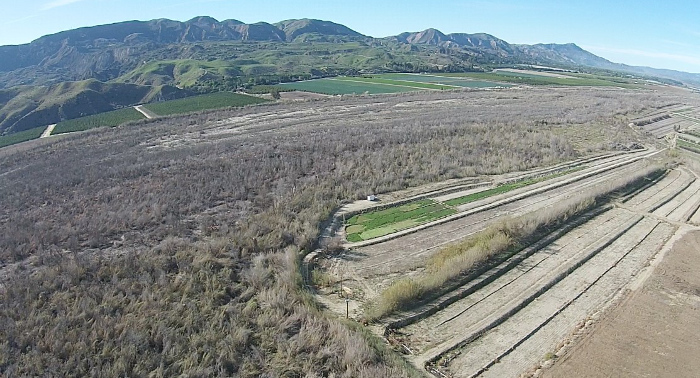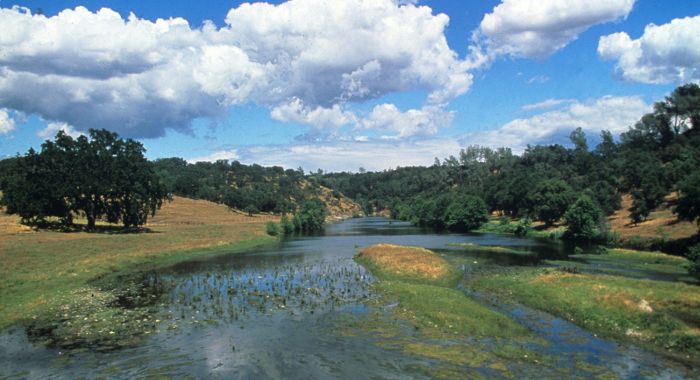In a normal year, groundwater accounts for 40 percent of California’s water supply. That number jumps to 60 percent during a drought. It’s also critically important for sustaining certain types of aquatic, terrestrial and coastal ecosystems.
Yet decades of unregulated groundwater withdrawal has compromised that ability to provide for people and nature. Wells dry up, water quality declines, and rivers, wetlands, and springs disappear.
To address this problem, California passed legislation requiring that groundwater basins be managed sustainably. We still face gaps, however, in our understanding of how to manage these basins to ensure the health of the ecosystems they support. Conservancy scientists are working with water managers and state agencies to close those gaps.


Erin. E. Conlisk, Gregory H. Golet, Mark D. Reynolds, Nathan Elliot. and Matthew E. Reiter
Shorebirds are the second fastest declining group of birds in North America. To reverse this trend, The Nature Conservancy has been implementing BirdReturns, a habitat incentive program that pays…Michael J. Clifford, Sophie S. Parker, Laurel Saito, Brian S. Cohen, Naomi S. Fraga
Lithium batteries are important for the clean energy transition in the United States because they are used in electric vehicles and for grid power storage. However, lithium extraction may have impacts…Sophie S. Parker, Michael J. Clifford, Brian S. Cohen
To address climate change, the United States is incentivizing the production of electric vehicles containing domestically derived lithium batteries. Extracting this lithium may have environmental…Michael Clifford, Sophie Parker, Matt Rader, Lydia Bailey, Naomi Fraga, Chris Hass, Estella Hernandez, Jan Kempf, Lois Merkler, Michael Swink
The Amargosa River supports one of the most outstanding suites of endemic and imperiled species in the world. In 2019, TNC acquired the Atwood Preserve in the river’s headwaters, the…Adam H. Love, Andy Zdon, Naomi S. Fraga, Brian Cohen, Maura Palacios Mejia, Rachel Maxwell, Sophie Parker
This paper presents results from the Mojave Desert Springs research project. The authors present a comprehensive statistical analysis of similarities between California desert springs. An observed…Naomi S. Fraga, Brian S. Cohen, Andy Zdon, Maura Palacios Mejia, Sophie S. Parker
This paper presents novel botanical inventories of 48 desert springs as part of the Mojave Springs Research Project. The authors assess plant species composition and richness within and between…Erin E. Conlisk, Kristin B. Byrd, Elliot Matchett, Austin A. Lorenz, Michael Casazza, Gregory H. Golet, Mark D. Reynolds, Kristin A. Sesser, and Matthew E. Reiter
Landscape-scale wetland conservation requires understanding how wildlife responds to dynamic freshwater habitat availability. This study examined this for dabbling ducks by comparing habitat…Sophie S. Parker, Bradley Franklin, Brian S. Cohen, Melissa M. Rohde, Michael Clifford, Andrew Williams
Climate change will cause severe financial, social, and environmental upheaval if a massive reduction in carbon emissions is not achieved by 2030. To address this challenge, rechargeable lithium-ion…Gregory. H. Golet, Kristen. E. Dybala, Matthew. E. Reiter, Kristin. A. Sesser, Mark Reynolds, Rodd Kelsey
Shorebirds have declined precipitously in North America in the last 50 years, primarily due to the loss of wetlands. Incentive programs that pay farmers to create temporary wetland habitat on idled…Melissa M. Rohde, Tanushree Biswas, Ian W. Housman, Leah S. Campbell, Kirk R. Klausmeyer, Jeanette Howard
Groundwater dependent ecosystems (GDEs) are increasingly threatened worldwide, but the shallow groundwater resources that they are reliant upon are seldom monitored. In this study, the researchers…Melissa M. Rohde, Tanushree Biswas, Ian W. Housman, Leah S. Campbell, Kirk R. Klausmeyer, Jeanette Howard
Groundwater dependent ecosystems (GDEs) are critical habitats throughout California that rely on shallow groundwater. Unfortunately, only a small subset of wells provide monitoring data for shallow…Melissa M. Rohde, John C. Stella, Dar A. Roberts, Michael Bliss Singer
This study combines satellite, groundwater, and streamflow data over a 5 year period (2015-2020) to understand the impacts of groundwater depth and streamflow alteration on groundwater-dependent…Sarah M. Yarnell, Ann Willis, Alyssa Obester, Ryan A. Peek, Robert A. Lusardi, Julie Zimmerman, Theodore E. Grantham, Eric D. Stein
Very few rivers have protections to protect flow for species and ecosystems, in part because of the complexity and resources required to develop ecological flow criteria - the amount of water needed…Kelsey Jessup, Sophie S. Parker, John M. Randall, Brian S. Cohen, Rowan Roderick-Jones, Shona Ganguly, Jill Sourial
This paper presents results from Planting Stormwater Solutions, part of TNC’s Urban Conservation work in Los Angeles. The authors develop a methodology to prioritize siting of vegetated…Kristen Wilson, Dale W. Johnson, Douglas F. Ryan, ed.
Authored by TNC staff and colleague, Chapter 8 of this report synthesizes environmental monitoring and studies performed at Sagehen Experimental Forest that are relevant to water quality regulatory…Christopher Dillis, Van Butsic, Jennifer Carah, Samuel Zipper, Theodore Grantham
Water management practices for cannabis farming in California are not well understood. This study examined permit reporting data and found that the vast majority (>75%) of permitted cannabis farms…Barton H. Thompson, Jr., Melissa M. Rohde, Jeanette K. Howard, Sandi Matsumoto
In 2014, California’s landmark Sustainable Groundwater Management Act (SGMA) promised comprehensive management of California’s groundwater. This report, Mind the Gaps: The Case for Truly…Kirk Klausmeyer, Jeanette Howard, Melissa Rohde, Charlotte Stanley
The first step to sustainably manage groundwater dependent ecosystems (GDEs) is to identify where they are. The Nature Conservancy developed a statewide spatial database that provides locations of…